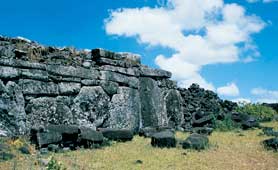
Formed by a series of massive volcanic eruptions, the island was only inhabited by sea birds and dragonflies for millions of years. Its steep slopes, however, stood out like a beacon to a weary group of Polynesian seafarers. The first inhabitants developed a mysterious culture.
The Polynesian name of the island is Rapa Nui, which is a name given by a Tahitian visitor in the 19th century who says that the island looked like the Tahitian island of "Rapa", but bigger, "Nui".
The islanders, once settled, gradually spread across the island, occupying nearly all the available areas.
They were greeted with a lush tropical paradise when they first discovered it. The trees were cut for lumber for housing, wood for fires, and eventually for the rollers and lever-like devices used to move and erect the Moai, and also to plant their crops, they resorted to slash and burn agriculture to remove the forest cover, and finally the productivity of the land declined.

The appearance of stone statues on Easter Island is neither mysterious nor unexpected. They are clearly related and spring from common belief systems and religious practices. The Moai are seen all over the island, and in different shapes, sizes, and stages of completion. Many Moai are left unfinished at the quarry site. No one is sure yet as to what purposes did the Moai served, but outside scholarly research together with accumulated local knowledge, shows evidence that the Moai were carved by the ancestors of the present inhabitants.
The exact number of moai on Rapa Nui is unknown because many lie buried in piles of rubble or beneath the soil at the statue quarry; the estimates vary from 800 to 1,000.
The hardy Polynesians who found Rapa Nui came prepared to stay. They brought tools and food, plants and animals to begin a new life. But the island they found is not a typical Polynesian paradise: it is out of the tropics, and has neither rivers nor protective reefs. But, although it had a forest of large palms and other trees, and craters held drinking water.
Easter Island has one of the richest collections of Petroglyphs in all Polynesia. Around 1,000 sites with more than 4,000 petroglyphs are catalogued. Designs and images were carved out of rock for a variety of reasons: to create totems, to mark territory or to memorialize a person or event.

The arrival of the first inhabitants of Easter Island is linked to the population of America. There are several theories, the most important are: first is the thesis of Montando, which suggests a Malasian - Polynesian migration of australoid slaves, which settled in Easter Island. The Polynesians were good navigators, for that reason they took the Australians to Easter Island, and then to the American coast, because the Australians slaves escaped from their owners, and arrived in America. Other theory, Heyerdahl argued that Polynesia must have been settled by advanced societies of American Indians, who in turn must have received civilization across the Atlantic from more advanced societies of the Old World. But there are few elements to support this theory.
The Easter Islanders have their own theory for their origins. The island was populated by the descendants of a chief called Hotu Matua, who migrated to an island that had appeared in the dreams. The reasons were the climatic changes or maybe conflicts with another tribe.

That culture's most famous features are its enormous stone statues called moai, over 300 of which once stood upon massive stone platforms called ahu, these are mainly near the coast. The crucial centres of ceremonial activity were the ahu, were the sanctuaries of the people of Rapa Nui, and the moai statues were the ritually charged sacred objects of those sanctuaries.These are the Ahu Moai. The "Mana" or spiritual presence of Rapa Nui is still strongly present at the ahu sites and a top of the sacred volcanoes. The level of intellectual achievement of at least some parts of Easter Island society can be judged by the fact that a number of these ahu have sophisticated astronomical alignments, usually towards one of the solstices or the equinox. At each site they erected between one and fifteen of the huge stone statues that survive today as a unique memorial to the vanished Easter Island society. It is these statues which took up immense amounts of peasant labour. The statues were carved, using only obsidian stone tools, at the quarry at Rano Raraku volcano. They were fashioned to represent in a highly stylised form a male head and torso.

» Ceremonial circle.